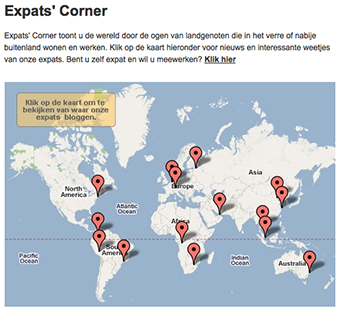Life is tough for the newspaper industry these days, and survival is not assured. Whatever strategy a newspaper takes, one thing is for sure: They need to keep costs low. Yet newspapers still need to compile compelling content that can engage their reading communities. Social media can help a great deal in solving this problem. Here are seven attention points which could help to increase content production while staying cost effective.
1. Publish your raw material.
Readers are eager to read “works in progess” when they appear on blogs. The first reactions of beat reporters as they encounter breaking news could be fascinating reading, for instance. Put part of your coverage planning online and ask the community for ideas and input; meetings notes, for example, can be turned instantaneously into blog posts. But be sure to make it obvious that this is still a work in progress and that the opinions and facts may change.
2. Do not worry too much about the style.
Blog posts don’t have to be polished. Jot down whatever quick notes you have or use a simple camera such as a Flip to ask reporters what is happening. Our experience is that the audience is very tolerant for experiments in the context of a blog, so if you are worried about the style of a particular piece, try it out in a blog format first.
3. Think about events that can go live quickly in raw format.
Press conferences, conferences, shareholder meetings, etc. Well, as writing journalists, we simply write down what happens, don’t we? So why not publish it immediately on a live blog or with streaming video? It is not always necessary to run a more traditional story afterward, although, of course, it can be done — especially if that story provides context or additional insights.
4. Avoid falling in love with complex interactive Flash documents.
Give them a hard look: How many hours did it take to produce them? How many page views did they generate? Compare this with other story formats — sometimes plain text with a picture or a simple video is more effective. If the urge to make Flash documents is irresistible, at least be sure that the animation is re-usable.
5. Videos, too, can be raw.
As we discussed in a previous post, the same idea applies to videos. People want content that 1) interests them and 2) connects them with the guys in the newsroom. The YouTube generation is not necessarily waiting for yet another highly polished television-style program.

6. Mobilize your community for user-generated content.
Your readers can be a good source of content, as well. One needs to guide such projects carefully, but people are often willing to contribute a great deal. Moreover, other members of your community are eager to read and watch what their fellows produce. We are running a community for expats now and are planning to start other communities around specific themes. Forums are another way to gather lots of user generated content, but here again guidance should be provided — either by trusted community members or by the newsroom.
7. Link journalism.
Why should we try to do everything ourselves? Focus your efforts on the stories your community considers really important. Other stories may be fun to know but less crucial — or perhaps you just don’t have the resources to develop them thoroughly. In those cases, just link to coverage on other sites — even if those sites are competitors. We are using this approach on our financial Bear&Bull blog, using FriendFeed. Even though you send your audience away, they will still come back, knowing that the interesting stories that you do cover you cover well. The journalist today is not only a creator, but also a curator.
Never give up on training
There is one area where you should never cut costs: training. Companies that no longer invest in training and research will die. If you see that your company is giving up on this, you should leave. Furthermore, in the long run, training helps save money, since it enables fewer people to do more. Teach your journalists the basics of taking digital pictures and making video, as well as elementary picture and video editing. You might continue to use professional photographers for those major front-page pictures that define the look and feel of your site or newspaper, and rely on pictures made by the writing journalists elsewhere. Hiring the “experts” for even the small details could quickly become expensive, so using writers’ photos could help control costs.
Taking pictures even helps a writing journalist to get a better feeling for her own story. Moreover, it is fun to learn those basics! Just about everyone takes pictures or shoots video privately — and it just is more fun if you have some idea of what you are doing.
The same applies for animations and Flash. Not every writing journalist needs the skills of an accomplished Flash specialist — far from it. But an introductory course helps because it enables better communication between your reporters and your resident Flash experts and better dialogues means shorter production time. Furthermore, it enables journalists to make simple updates to existing Flash documents, so that the “real experts” can focus on the heavy duty work.
Training also increases productivity. If the training is truly interactive and exciting, it makes work more fun and generates new ideas — and a happy newsroom produces more and better stories!
These are just a few things to consider when thinking about how to lower production costs via social media. What other ways do you see using social media to get more content while keeping costs under control?
Roland Legrand is in charge of Internet and new media at Mediafin, the publisher of leading Belgian business newspapers De Tijd and L’Echo. He studied applied economics and philosophy. After a brief teaching experience, he became a financial journalist working for the Belgian wire service Belga and subsequently for Mediafin. He works in Brussels, and lives in Antwerp with his wife Liesbeth.


This is a lot of good advice. It’s true that the substance of many posts with trump style in blog format. Good to think about for my next project.
Great post, and thanks for encouraging participatory journalism. We are all the media now and this is a great time to be in a position to share everything from the latest news to your particular opinion about it.
Well done, I appreciate the insights, it seems just when I thought I could keep up with the pace, everything started moving faster. New to this site, but will definately be back.
Thanks for the good advice. Point 7 may be especially practical. Provide fresh insight but otherwise link to high quality sites for reliable information rather than reiterating. Competition is passé, cooperation is key for sustainability.
Good point about training too.
As both an employee communications manager and new author of a personal blog, I think these are some great points that are applicable to the success of engagement in personal and professional settings. Thanks!
Hie.
Thanks a lot for this knowledge-full post.
I totally agree your position about videos. But let me tell you tha Picture has a different status on the Web : no timeloosing, quickly understood, easy to share an mobilize.
That’s what i tryed to explain on my blog (in frenc, sorry) here: http://exercicedestyle.fr/2008/12/30/l%E2%80%99image-un-espoir-pour-le-journalisme-professionnel-sur-internet/
Many thanks.
Emmanuel.
Thanks for sharing, makes a lot of sense not only to a newspaper company, but also to anyone who is into online publication be it a blog, social network or freelance author.
@Emmanuel thank you for the link. Interesting insights about images!
Thank you for this insight! Great perspective!
Really thats a good step to do somthing which is really good for music.I like it.